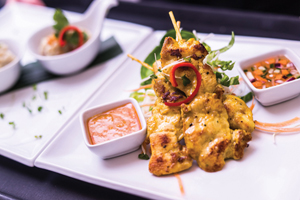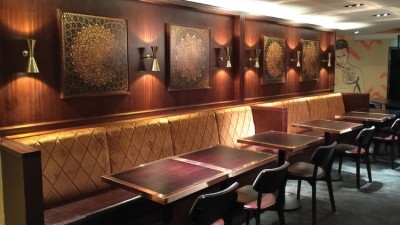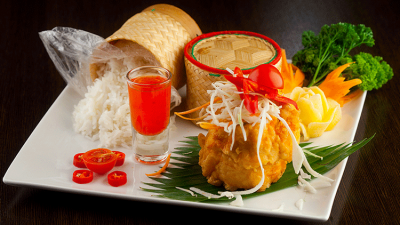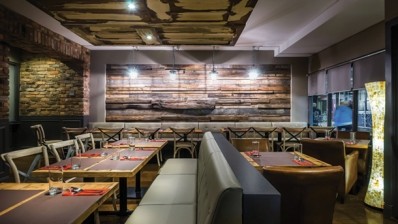Business Profile: Giggling Squid
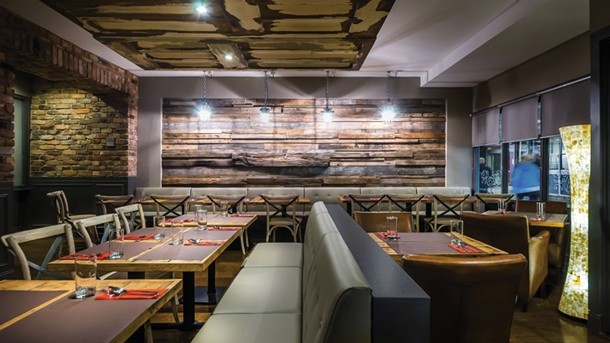
His group’s flexibility on property – he and wife Pranee are happy to set-up shop in less obvious smaller towns that aren’t often considered by chains — has seen it grow at an impressive rate with little external investment.
There are 13 Giggling Squids currently trading in the south of England, the majority of which are within (or at least near to) the commuter belt, and the group looks likely to double that figure by this time next year.
Competition in the Thai restaurant space has intensified in the past five years or so with a number of expanding brands – including London-based Busaba Eathai and Rosa’s as well as the mostly north-based Thai Leisure Group (which comprises the Chaophraya and Thaikun brands) – vying to become the country’s first national Thai restaurant chain.
Giggling Squid will soon be leading the pack in terms of number of sites but whether it can be considered the front runner depends on what metric is used. Busaba Eathai, for example, operates the same number of restaurants but turns over around twice as much cash.
Brand savvy
Unlike the majority of its competitors, Giggling Squid doesn’t really look like a Thai restaurant – if the name and logo wasn’t anchored by the words ‘Thai restaurant’ you’d never know it served Thai food until presented with a menu.
“The feel of our restaurants is not overtly ethnic. This is an important part of our brand and one of the principle factors behind our success. Thai-themed restaurants can be intimating. This more neutral approach repositions us as somewhere that’s easy going and a good option for lunch,” says Laurillard, who held marketing and brand management roles at companies including Unilever and Coca-Cola before entering the restaurant business at the age of 30.
The group started life in 2002 in an awkwardly shaped building in Brighton’s The Lanes. Called Mai Ped Ped Ped, it was just 1,100sq ft with no room for a coffee machine, but performed well enough to fund a second site in Hove, which the pair named Giggling Squid.
“The first restaurant was profitable but our second restaurant in Hove was so successful we realised we had created a brand that was scalable. Five years ago we rebranded Mai Ped Ped Ped to Giggling Squid and have seen sales double. The menus at the two sites are identical so that uplift was down to that transition from a generic Thai to a branded proposition,” says Laurillard.
As a result, the couple hope to giggle all the way to the bank and are in the process of securing a major funding deal, with private equity understood to be the preferred option. This year the group appointed accountancy company Grant Thornton to help it find investment.
It’s not likely to be difficult. The company’s success has not gone unnoticed. The Business Growth Fund – a consortium of investors that includes several major banks – is believed to have run the rule over the business and a number of other organisations have apparently been sniffing around. The corporate funding process is roughly at the half way point, says Laurillard, who is understandably reticent on giving too much away about the group’s suitors.
Wide-ranging menu
Though billed as a ‘Thai tapas’ concept, Giggling Squid only offers its small plates at lunchtimes. There are tapas sets that typically include a curry with rice alongside two other dishes, for example the Hungry Squid, which comprises green chicken curry, jasmine rice, chicken satay and mixed vegetable stir-fry.
Tapas dishes can be ordered individually and daytime diners can also opt to have one larger dish served with rice. Spend per head during the day ranges from £12 to £15.
Laurillard says that allowing people to try a range of dishes moves Thai food away from its association with “curry and a few pints” and plays a huge role in driving lunchtime trade, traditionally a quiet period for Thai restaurants (and indeed Indian and Chinese ones).
“It’s also an excellent way of attracting female diners. At lunchtimes women often outnumber men by five to one. In fact, I was eating at one of our branches recently and I was the only man in the dining room,” he says.
In the evenings the prices shift up a notch or two and the menu is more wide ranging, reverting to a more traditional à la carte structure. Spend per head is between £25 and £30 depending on location. Like the lunchtime menu, it is primarily concerned with approachable Thai food made with familiar ingredients.
“When people talk about authenticity it makes me laugh. If you want authentic food go into the kitchen and eat what the chefs are cooking for themselves, that will blow your mind,” says Laurillard.
“There’s authenticity to the flavours and spices we use, but it’s sanitised. Niche restaurants may be viable in London, but where we operate people don’t want challenging flavours or curries with meat on the bone. Our job is to make Thai food accessible for the UK market.”
Most UK Thai restaurant staples are available – including chicken satay, pad Thai, fishcakes, green and red curry – but some less obvious dishes are offered too, including Bangkok street–food classic moo ping (marinated grilled pork) and a couple of rustic stir-frys such as grad pao (meat cooked with holy basil, chilli and garlic) and pad prik (somewhere between a very dry curry and a stir fry made with curry paste).
As the name implies there is a bias toward seafood dishes, but there’s plenty for meat eaters and vegetarians. Pranee – who has a background in restaurants – oversees the food side and writes all the menus, which are identical across the group, save minor price variations depending on location.
The right location
An ideal pitch for the brand is currently a big area of discussion. “We have a variety of different locations so it’s hard to describe exactly what makes a great Giggling Squid site,” says Laurillard.
“You have to be interested in sites and locations in this game. Nothing shapes a business more than property decisions. You can get the staffing and menu perfect, but if you are in the wrong place it will all be for nothing.”
He takes the group’s Horsham restaurant as an example. Located on East Street – a semi pedestrianised road that’s colloquially known as Eat Street because of the huge number of national chains that line it – the restaurant does strong business at lunchtimes and in the evenings, but takeaway business is poor because of limited vehicular access.
“It’s a trade off. In some sites we have less lunch trade because we’re a little off-pitch from the main retail area. For example, in Henley we don’t do that many lunches, but we get excellent takeaway business because we’re right on the road into town. Up to 15% of sales, in fact. That’s a lot of money, comparable to our total occupation cost.”
Locations that can provide a strong lunchtime business and takeaway sales – including those in Tunbridge Wells and Marlow – always net Laurillard the best return on his capital.
“Our off-peak trade is strong, which allows us to trade effectively out of relatively small sites. Operators with businesses heavily weighted to Friday and Saturday nights need to take much bigger sites so they can do high volumes at peak times,” says Laurillard.
This has been crucial to the brand’s speedy growth. Giggling Squid’s willingness to take smaller units in less obvious locations – for example Billericay and Reigate – has seen it outpace groups with considerably better contacts, covenant strength and manpower. “We are explicitly after the local Thai market trade. We’ll stay away from the big cities and leave the big boys to fight it out,” says Laurillard.
“Everybody is looking for 4,000sq ft boxes in places such as Manchester and Leeds. That’s very expensive. We’re making a great living in smaller market towns, and long may that continue.”
Earlier this summer, the group closed an underperforming site in Crawley. Laurillard is honest and open about his group’s first property misstep. “It was in the wrong location in the wrong town. It was just about profitable but it wasn’t worth the resources. It taught us a lot. It was the wrong demographic. Footfall is only useful if people that walk past might end up in your restaurant,” he says.
Despite speculation to the contrary, Laurillard is adamant that larger Thai restaurant businesses won’t consolidate.
“All the branded groups have different operational models and site criteria. Thai Leisure Group and Busaba take huge sites in big cities. Neither intend to pop up in Horsham any time soon. We’re all so different. I can’t see it,” he says.
He does, however, expect consolidation, of sorts, in the independent Thai sector. “There are something like 1,500 Thai restaurants in the UK and around 1,450 of them are either one-off independents or part of small family owned groups. The branded chain’s share of the market is tiny at the moment, but as they expand they will inevitably start taking over the independents,” he says.
Workforce
Independent Thai restaurants already provide much of Giggling Squid’s workforce, which is overwhelmingly Thai to the tune of about 85%.
“It’s not strictly necessary to have that many Thai people working for us, but we’ve found it very easy to recruit from the UK’s Thai community,” explains Laurillard. “It’s largely a word-of-mouth thing. To be frank, many independent ethnic restaurants don’t play by the rules and consequently the working conditions can be quite poor. People tend to seek us out rather than the other way round.”
Giggling Squid is not licensed as a sponsor of immigrant workers so doesn’t suffer the acute logistical and financial headaches associated with bringing into the country non-EU talent on work visas.
Thai front-of-house staff are highly useful because they understand the food and can hit the ground running, but the Laurillards are happy to employ non-Thai’s on the restaurant floor. It’s in the kitchen where the pair deem Thais to be essential.
“There’s no centralised production so all pastes and sauces are made on site from scratch. To serve food at the level we want to, we need people that know the real taste. Their skills with the wok are also invaluable.”
The food may not be bought in, but the group is big on outsourcing at head office. Unusually for a group its size Giggling Squid doesn’t employ a finance director, with many functions handled externally or by Laurillard himself.
Throw long road trips in search of new sites for the group into the mix and Giggling Squid’s MD is a busy man indeed – but then he has given himself the somewhat ambitious brief of taking the brand to 250 restaurants. Last month saw him view sites in locations as far flung as Nottingham and Plymouth, which gives some clue as to how far he soon intends this cephalopod’s tentacles to reach.

